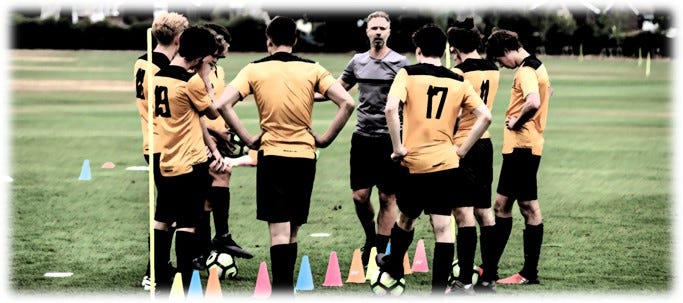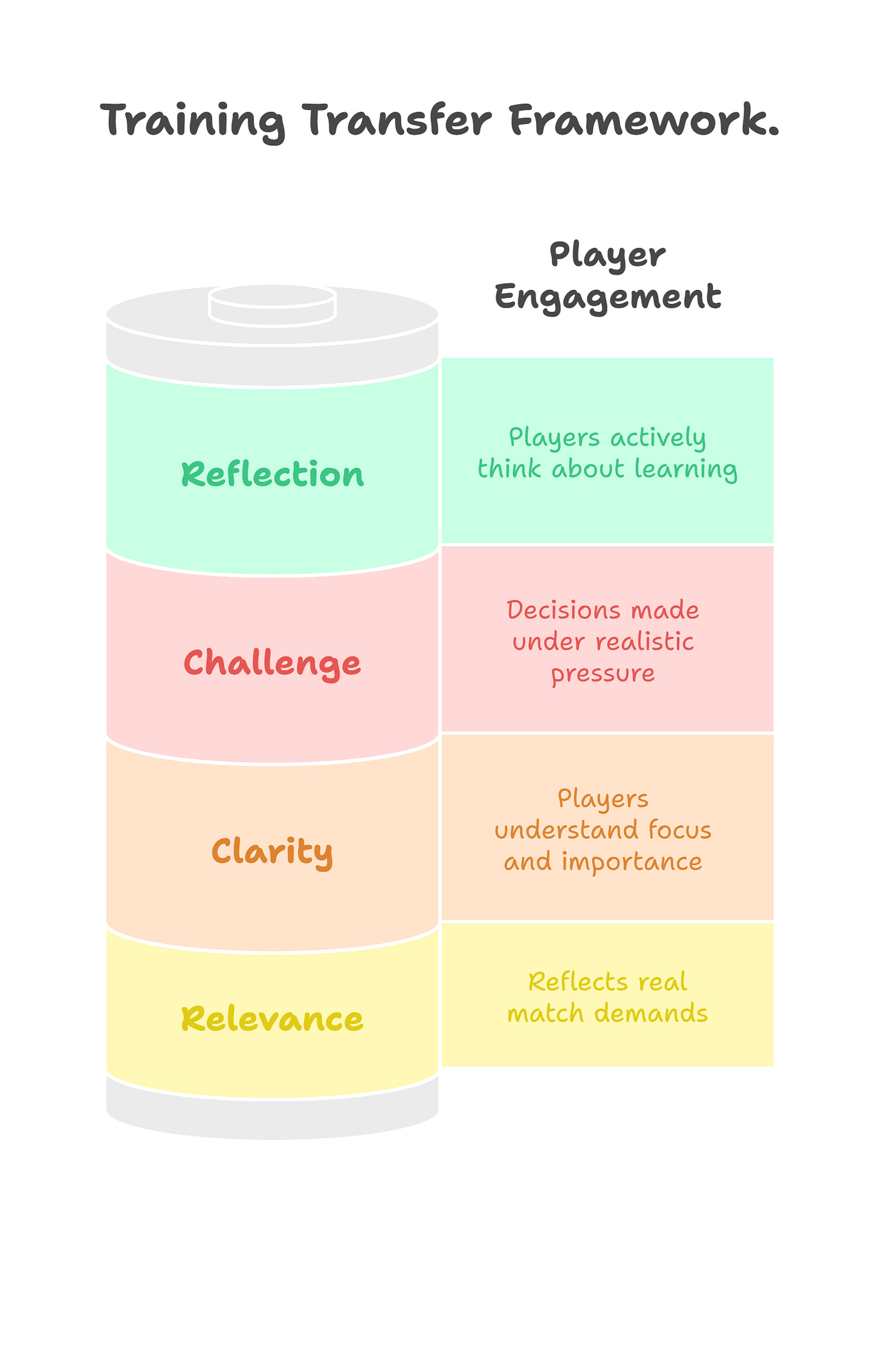Welcome from JustCoachMD. We are happy to have you on board and look forward to providing you with helpful content.
Here is What to Expect:
Coaching Craft: Transferring training into game impact.
Full 60-Minute Practice: Decision-making practices.
You train how you play. If you do not train with intensity, how can you play with intensity? - Pep Guardiola
⚽Designing Sessions That Transfer: Turning Training into Game Impact
You’ve planned a sharp session. It runs smoothly, players look great in practices…
However, come game day, the same problems resurface. Why? 🤔
The issue isn’t always effort or execution—it’s transfer. What players do in training doesn’t always carry over to performance under pressure.
The best coaches don’t just run great sessions—they design them so learning sticks and shows up when it matters. Let’s build sessions that transfer. 💥
🧠 The “Training Transfer” Framework
Build every session around these 4 Transfer Drivers:
🎯 Relevance – Does it reflect real match demands?
💡 Clarity – Do players know the focus and why it matters?
⚔️ Challenge – Are decisions made under realistic pressure?
🔁 Reflection – Are players thinking about what they’re learning?
✅ Step 1: Start with the Game, Not the Drill
🎬 “Game First” Planning
Always begin with the game problem, not just a cool practice. What moment from last weekend do you need to solve?
Example:
❌ Problem: Can’t play through a high press
✅ Solution: Train third-man movement and timing in the buildup
Coach Actions:
Watch recent game footage 📹
Identify tactical pain points 🔍
Design practices that simulate that moment 🎯
Ask Players:
“Where did we get stuck in our last game?”
“What movement or decision could’ve helped?”
“What are we working on solving here?”
Football is about making decisions. The more you help players understand the game, the better decisions they make. - Carlo Ancelotti
🔄 Step 2: Build Decisions Into Every Drill
🧩 “Game-Like Reps”
Technique is vital—but context is king. Don’t just pass and move. Add decisions, timing, and pressure.
Upgrade Examples:
🔁 Passing pattern ➡ Positional possession with pressure
🎯 Finishing drill ➡ Transition game with live defenders
👀 Scanning ➡ Tie it to triggers and cues
Coach Actions:
Start passive, build to live defenders 💪
Use game language for instructions 🗣️
Challenge players to choose, not just execute
Ask Players:
“Why did you play that pass?”
“What did you see before you received?”
“How does this relate to our game plan?”
🧱 Step 3: Add Constraints and Context
🎮 “Pressure + Purpose”
Make it real. Real time, real space, real consequence.
Constraint Ideas:
➡ Directional play
🧍♂️ +1 overloads or underloads
⏱ Time limits for decision-making
Context Ideas:
🔁 Turnovers lead to immediate counterattacks
🧤 Keepers as the first attacker in the buildup
🧠 Coaching as opposition (“Try to press us like [last week’s opponent]”)
Coach Actions:
Explain the “why” before every activity 🧠
Add meaning to outcomes (win the phase = point, goal = bonus) 💯
Coach individual decisions inside the game flow 🎯
Ask Players:
“How did that feel compared to a real game?”
“What could you have done to escape pressure?”
“Which options were realistic under this setup?”
🪞 Step 4: Build Reflection into the Session
🗣️ “Think + Link”
If they reflect, they retain. Build pauses, questions, and feedback into your session rhythm.
Reflection Strategies:
⏸️ Freeze & ask: “What were your options?”
🔁 Peer coaching: “Ask a teammate what they saw.”
📓 Match-prep journals: “What mindset or action improved today?”
Coach Actions:
Let players debrief in pairs 👥
Assign roles (observer, speaker, responder)
Use post-session voice notes or short videos to recap 🎤
Ask Players:
“What was the key decision in that moment?”
“What are you taking into Saturday’s match?”
“Did you solve the problem or avoid it?”
📊 Step 5: Track It With Game Model Markers
🎯 “Did It Show Up?”
Measure training impact by what shows up in games, not what looks good on Tuesday.
Game Model Markers Examples:
✅ # of successful third-man plays
🚀 Recovery runs after ball loss
🧱 Midfield rotations to escape pressure
Coach Actions:
Define 3–5 priority behaviours weekly
Track with video/stats/notes during matches 📋
Celebrate transfer, not just technique 🙌
Ask Players:
“Did you use what we worked on in the game?”
“Where did our pressing or buildup improve?”
“What’s the next layer we can build?”
A footballer must feel in training what he will face in a match. - Marcelo Bielsa
🧰 BONUS: Quick Planning Checklist
When designing your next session, ask yourself:
✔️ Did I start with a game situation or tactical goal?
✔️ Is there meaningful decision-making under pressure?
✔️ Are there real game constraints (space, time, opponents)?
✔️ Do players know why we’re doing this?
✔️ Is reflection or feedback built in?
✔️ Can I measure if it shows up on match day?
🧠 Final Thoughts: Coaching for Transfer = Coaching for Impact
High-tempo drills look sharp. But matches aren’t drilled based—they’re chaos, emotion, and pressure. 💥
Design for decisions. Train with intention. Coach to transfer, not just to teach.
Every time you plan, ask yourself:
“Will this show up when it matters most?”
Let your sessions do more than impress. Let them translate. ⚽🔁🔥
Understanding the game is more important than just playing it. If you can read the game, you are already faster. - Xabi Alonso
The Practices: Receiving to Play Forward
1v1 (+2) | Receiving to Play Forwards
⚽️ Created On: @SSP
Aim:
Players need to find a way to receive in a forward-facing position and play forwards.
Set-Up:
20 by 15 yard pitch space, split the field in half. One player for each team is locked into a half.
👕Teams: 🔴’s vs ⚫️’s plus 🟡’s support players.
How to Play:
🔴’s & ⚫️’s compete for possession.
Teams aim to keep possession using the 🟡 support players. The ball must be received in each half of the pitch before being passed into the opposite 🟡.
Initially, once the ball passes the halfway line, the player receiving it cannot pass the ball backwards; they must find the spare player (🟡) before passing it back in the other direction.
Once the ball has been played from a 🟡 at one end to the 🟡 at the opposite end, this locks in a goal for the attacking team.
Progress the game by allowing a player 🔴 or ⚫️ in one half to set the ball back to one of their teammates in the other half, and then play into the 🟡’s.
Allow players to rotate to get on the ball.
Finally, remove the halfway line and play the game as a 2v2 plus 2.
Please note that you could make the pitch bigger, then have x2 games of the same practice happening at the same time (creates a little more game-like chaos)
🚧 Constraints:
🏆Reward: Play for points (first team to 6), players get double points for playing first time into the 🟡.
👨🏫 Review: Player’s body shape to receive the ball.
🚫 Restriction: The Attacking team cannot pass back to the 🟡 who passed you the ball unless it’s been received in the other half.
2v2 (+4) | Receiving to Play Forward
⚽️ Created On: @SSP
Aim:
Combining through the zones of the pitch to play through pressure.
Set-Up:
30 by 20 space. Split the field in half and add mini-goals (one goal in each half-positioned as shown). Players are locked into the half for a 2v2.
👕Teams: 🔴’s vs ⚫️’s play 2v2 centrally in each zone, 🟡’s & 🟢’s act as support players at each end.
How to Play:
The possession team must play through the zones of the pitch to score a goal.
There are a pair of support players (🟡’s and 🟢 '‘s) at each end who are limited to one touch each. They can pass to each other twice before playing into the main playing area.
Progress by letting a player from the team in possession (🔴 or ⚫️)support underneath the ball when their team is in possession. This player is limited to one touch in the half they have moved into.
Remove the halfway line and allow teams to play 4v4 plus 4. Rotate the central players with outer targets.
🚧 Constraints:
🏆Reward: One-touch combinations from targets at one end to the opposite targets with three goals.
👨🏫 Review: Secure the ball or play forwards.
🚫 Restriction: One touch limit if you join the opposite half (🔴 or ⚫️).
4v4 (+2) | Controlling Possession | Changing Tempo
⚽️ Created On: @SSP
Aim:
Spotting opportunities to speed up or slow down the game tempo.
Set-Up:
40 by 30 pitch space with 5-yard scoring zone (blue & red shaded areas). Place a halfway line in the middle of the pitch.
👕Teams: ⚫️’s vs 🔴’s plus 🟡’s acting as support players.
How to Play:
⚫️’s vs 🔴’s with support from the 🟡’s.
The team in possession connects 3-5 passes in a half, then breaks out into the other half to try and score in the shaded zone. Each team must have a player in the opposing half to play up to or defend against.
If a team is successful in scoring, they keep possession of the ball and attack in the other direction.
If the defending team wins the ball, they aim to connect the passes and then try to score.
The 🟡’s can play the final pass into the other half. They act as support for the possession team.
🚧 Constraints:
🏆Reward: Regains followed by 2 passes = a goal for securing possession
👨🏫 Review: The player’s decision to make an extra pass or play up/through to their attackers.
🚫 Restriction: a time limit to score in the other half, otherwise the defenders become the possession team.
We have to change from doubters to believers. - Jurgen Klopp
I send this email weekly. If you'd like to receive it, why not join a community of like-minded people who share a passion for the game of football?
Enjoyed reading this post, feel free to share it with your friends! Or click the button below so more people can discover us.









